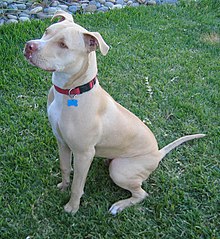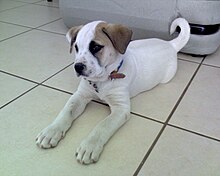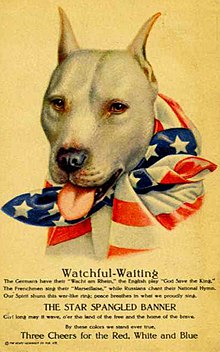American Pit Bull Terrier
It has been suggested that Old Family Red Nose be merged into this article. (Discuss) Proposed since January 2013. |
| American Pit Bull Terrier | |||||||||||||||||||||||||
|---|---|---|---|---|---|---|---|---|---|---|---|---|---|---|---|---|---|---|---|---|---|---|---|---|---|
 | |||||||||||||||||||||||||
| Other names | Pit Bull | ||||||||||||||||||||||||
| Common nicknames | APBT, Pit, Pitty, Pibble, Pitt Bull | ||||||||||||||||||||||||
| Origin | United States | ||||||||||||||||||||||||
| |||||||||||||||||||||||||
| Dog (domestic dog) | |||||||||||||||||||||||||
The American Pit Bull Terrier (APBT) is a medium-sized, solidly built, short haired dog whose early ancestors came from England and Ireland. It is a member of the molosser breed group. The American Staffordshire Terrier and The American Pit Bull Terrier (APBT) by breed are from the same lineage, Staffordshires was the name given by AKC, and American Pitt Bull Terriers by UKC. The real difference Between the two breeds is 6-8" in height and 25 to 35 lbs in weight. The APBT tends to be the larger of the two. This does not include the Staffordshire Bull Terrier.
The dog was bred first to bait bulls and bears. When bear-baiting and bull-baiting were deemed inhumane, rat-baiting and dog fighting became more popular. The APBT Breed was used in both sports, and its prevalence in being put in pits with rats, or other dogs led to "pit" being added to its name. The pitbull alone is not a breed, it is a generic term for a crossing of several strong dogs to produce ultimate fighting dogs.
The American Pit Bull is medium-sized, and has a short coat and smooth well-defined muscle structure. Its eyes are round to almond shaped, and its ears are small to medium in length and can be natural or cropped. The tail is slightly thick and tapers to a point. The coat is glossy, smooth, short, and slightly stiff, and can be any color.
Twelve countries in Europe, as well as Australia, Canada, Ecuador, Malaysia, New Zealand, Puerto Rico, Singapore, and Venezuela have enacted some form of breed-specific legislation on pit bull-type dogs, including American Pit Bull Terriers, ranging from outright bans to restrictions and conditions on ownership. The state of New South Wales in Australia places restrictions on the breed, including mandatory sterilization. A few counties, and cities in the United States as well as the Province of Ontario in Canada, have outright banned ownership of the American Pit Bull terrier, and the breed is banned in the UK.
History
During the 19th century, England, Ireland, and Scotland began to experiment with crosses between bulldogs and terriers, looking for a dog that combined the gameness, speed, and agility of the terrier with the strength and athleticism of the bulldog.[1]
In the late 19th century to early 20th century, two clubs were formed for the specific purpose of registering APBTs: the United Kennel Club and the American Dog Breeders Association. The United Kennel Club was founded in 1898, and was the first registry to recognize the breed, with the owner assigning the first number to his own APBT.[2]
The dog was bred first to bait bulls and bears.[3] When baiting bulls was deemed inhumane, ratting (a sport where a number of rats were placed in a pit for a specified time with the dog) and dog fighting became more popular. The APBT was used in both sports, and its prevalence in being put in pits with rats, or other dogs led to "pit" being added to its name.[4] With time, the dogs became more commonly domesticated due to their loyalty, loving and gentle nature with their owners.[5] In America, farmers and ranchers used their APBTs for protection, as catch dogs for semi-wild cattle and hogs, to hunt, and to drive livestock.[6] The dog was used during World War I and World War II as a way of delivering messages on the battlefield.[5]

Though of the same family, the American Pit Bull Terrier diverges in appearance from the Staffordshire Bull Terrier, having fewer bulldog traits in the face and body. The American Pit Bull is medium sized, having a short coat and smooth well-defined muscle structure, but should never appear bulky or muscle-bound. Its eyes are round to almond shaped, and its ears are small to medium in length and can be natural or cropped. The tail is slightly thick and tapers to a point. The coat is glossy, smooth, short, and slightly stiff and can be any color.[1] The breed ranges from a height of about 17 to 22 in (43 to 56 cm) at shoulders, females weigh between 30 and 50 lb (14 and 23 kg) and males weigh between 30 and 60 lb (14 and 27 kg).[2]
Temperament
According to the UKC,"This breed is eager to please and brimming over with enthusiasm. APBTs make excellent family companions and have always been noted for their love of children.[7] The APBT is a powerful and often times fearless dog with a high drive to please his master. Unfortunately, unfit owners at times have misused the APBT's trusting nature, training PitBull's for aggression and the results can be adverse.[8] The breed’s natural agility makes it one of the most capable canine climbers so good fencing is a must for this breed. This breed does very well in performance events because of its high level of intelligence and its willingness to work." [9]
Recently, American Pit Bull Terriers have been banned from several cities and counties, due to the general public's belief that Pit Bulls are naturally violent and aggressive towards people and other dogs. Contrary to popular belief, Pit Bull Terriers can be just as loving, caring, and loyal as any other dog breed. After further inspection, most deadly incidents involving Pit Bulls occur because of the manner in which the canine in question had been raised. Almost all of the fatal incidents involve Pit Bulls that had been trained for dog fighting. They are popular in the dog fighting world not because of their attitude or nature, but because they are an extremely strong breed of dog.[10]
Health

This section needs expansion. You can help by adding to it. (November 2009) |
The average life expectancy of an American Pit Bull Terrier is about twelve to fourteen years making them one of the longer living large breeds.[11] The breed tends to have a higher than average incidence of hip dysplasia.[12] They may also suffer from patella problems, thyroid dysfunction and congenital heart defects.[13] American Pit Bull Terriers with dilute coat colors have a higher occurrence of skin allergies.[14]
They are very prone to Demodex Mange due to their short coat. There are two different types of Demodex Mange, namely Localized and Generalized Demodex. Although it is not contagious it is sometimes difficult to treat due to immunodeficiency in some puppies. The Localized symptoms are usually lost of hair in small patches on the head and feet of the puppies. This type will usually heal as the puppies grow and their immune systems are stronger. The second type which is Generalized Demodex mange is a more severe form of the sickness. The symptoms are more severe and include loss of hair throughout the entire body and may also be scabby and bloody. Generalized are usually hereditary due to immunodeficiency genes that are passed on from Sire and Dam to their puppies. A simple skin scraping test will allow the vet to diagnose if the dog has demodex mange. The most widely used method to treat Demodex Mange is ivermectin injections or oral medications. Since Demodex Mange lives in the hair follicles of the dog, Ivermectin will kill these mites at the source.[15]
Varieties
Old Family Red Nose
Old Family Red Nose (OFRN) is an old strain of American Pit Bull Terriers known for their specific look and gameness.[16] A dog of the red-nosed strain has a copper-red nose, red lips, red toe nails, and red or amber eyes.
History
In the middle of the 19th century, there was a family of pit dogs in Ireland that were known as the "Old Family." At that time, all the strains were closely inbred. Closed genetic pool of that type, were likely to have a slide toward the recessive traits, because the dominants, once discarded, were never recaptured. Since red is recessive to all colors but white, the "Old Family" eventually became the "Old Family Reds." When the dogs began coming to America, they were beginning to show the red nose.[17]
The "Old Family" dogs found their way to America mainly via Irish immigrants. The term "Family dogs" was used in two ways: It could mean a strain of dogs that was a family unto itself that was kept by a number of unrelated people in Ireland, or it could refer to a strain of dogs that was kept and preserved through the years by a family group. It is believed, that the old Family Reds are of the first category.[18]
Many strains have been crossed with the Old Family Reds at some time in their existence. Consequently, nearly any strain will occasionally throw a red-nosed pup. To many dog owners, these red-nosed individuals are Old Family Red Noses even though the great preponderance of their blood is that of other strains. Sometimes such individuals will fail to measure up and thereby reflect undeserved discredit on the red-nosed strain. However the red noses produce their share of bad ones as well as good ones-just as all strains do.
As a strain, the Old Family Red Nose has several things going for it. First, it is renowned for its gameness. Second, some of the most reputable breeders in all Pit Bull history such as Lightner, McClintock, Menefee and Wallace have contributed to the preservation and development of the strain. Finally, as McNolty said in his 30-30 Journal (1967) "Regardless of one's historical perspective, these old amber-eyed, red-nosed, red-toe-nailed, red-coated dogs represent some of the most significant pit bull history and tradition that stands on four legs today."
Activities

Being intelligent, athletic dogs,[19] American Pit Bull Terriers excel in many dog sports, including weight pulling, dog agility, flyball, lure coursing, and advanced obedience competition. Out of the 66 dogs who have earned UKC "superdog" status (by gaining championship titles in conformation, obedience, agility, and weightpull), 23 have been American Pit Bull Terriers, and another 13 were American Staffordshire Terriers.[20] The American Pit Bull Terrier is a working dog, and is suitable for a wide range of working disciplines due to their intelligence, high energy, and endurance. In the United States they have been used as search and rescue dogs,[21] police dogs performing narcotics and explosives detection,[22][23] Border Patrol dogs, hearing dogs to provide services to the deaf, as well as general service dogs.
Law

Australia,[24] Ecuador,[25]Malaysia,[26] New Zealand,[27] Puerto Rico,[28] Singapore[29] and Venezuela[30] and twelve countries in Europe[31] have enacted some form of breed-specific legislation on pit bull-type dogs, including American Pit Bull Terriers, ranging from outright bans to restrictions and conditions on ownership.[31][32] The state of New South Wales in Australia places restrictions on the breed, including mandatory sterilization.[33][34]
Certain counties and cities in the United States have outright banned ownership of the American Pit Bull terrier, as well as the province of Ontario in Canada.[31][35] American Pit Bull Terriers are also on a list of four breeds that are banned in the UK.[36]
See also
- List of dog fighting breeds
- American Staffordshire Terrier
- American Bulldog
- Breed-specific legislation
- Bull and Terrier
- English Bull Terrier
- Pit Boss (TV series)
- Pit Bulls and Parolees (TV series)
- Staffordshire Bull Terrier
References
- ^ a b "American Pit Bull Terrier breed standard". 2008-11-01. Retrieved 2008-12-22.
- ^ a b "American Pit Bull Terrier (revised November 1, 2008)". United Kennel Club. Retrieved 2009-11-05.
- ^ "Bad Rap: Bay Area Doglovers Responsible About Pit Bulls". Archived from the original on 2008-08-22. Retrieved 2008-12-22.
- ^ Colby, Louis B. (1997). Colby's Book of the American Pit Bull Terrier. T.F.H. Publications. ISBN 0-7938-2091-X.
{{cite book}}: Unknown parameter|coauthors=ignored (|author=suggested) (help) - ^ a b Laratta, Diane (2008-02-17). "American Pit Bull Terrier ? friend or foe?". LimaOhio.com. Retrieved 2008-12-22.
- ^ APBTconformation.com
- ^ "United Kennel Club: American Pit Bull Terrier".
- ^ http://mrpitbull.com/PitbullTemperament.html
- ^ "American Pit Bull Terrier". 2008-11-01.
- ^ "Pit Bull Bans and the Human Factors Affecting Canine Behavior". 2007.
- ^ Morris, Deborah S. (2006-12-29). "Shelter defends pit bulls' rep". Newsday. Retrieved 2009-11-05.
- ^ Stahlkuppe, Joe (2000). American pit bull terriers/American Staffordshire terriers. Barron's Educational Series. ISBN 0-7641-1052-7.
- ^ "Statistics and Data – American Pit Bull Terrier". Orthopedic Foundation for Animals. Retrieved 2009-11-05.
- ^ Biomedcentral.com
- ^ "Shelter Medicine – Cornell Veterinary Medicine". Sheltermedicine.vet.cornell.edu. 2008-01-15. Retrieved 2011-10-26.
- ^ Red Nose History, The Encyclopedia of the American Pit Bull Terrier
- ^ Richard F. Stratton About the Red, Red Nosed, Bloodlines Journal, 1975, issue January–February
- ^ Richard F. Stratton The Truth About the American Pit Bull Terrier, 1991, ISBN 0-86622-638-9
- ^ "ASPCA: Pet Care: Dog Care: Pit Bull Information". ASPCA. Archived from the original on 2008-08-01. Retrieved 2008-12-22.
{{cite web}}: Check date values in:|date=(help) - ^ "UKC Superdog!". Retrieved 2011-12-13.
- ^ "So That Others May Live..." Retrieved 2008-12-22.
- ^ "Kool K-9 Popsicle retires". October 2002. Retrieved 2008-12-22.
- ^ "LawDogsUSA // Detection Dogs Made In America". Archived from the original on 14 January 2009. Retrieved 2008-12-22.
{{cite web}}: Unknown parameter|deadurl=ignored (|url-status=suggested) (help) - ^ "Customs (Prohibited Imports) Regulations 1956 No. 90, as amended – Schedule 1". Commonwealth of Australia. 2009-07-06. Archived from the original on 19 June 2009. Retrieved 2009-07-18.
{{cite web}}: Unknown parameter|deadurl=ignored (|url-status=suggested) (help) - ^ "Ecuador descalifica a perros pit bull y rottweiler como mascotas" (in Spanish). Ecuador: Diaro Hoy. 2009-02-04. Retrieved 2009-08-24.
- ^ A.Hamid, Rashita (2012-05-09). "Pit bull kills jogger". The Star. Kuala Lumpur, Malaysia. Retrieved 2012-05-09.
- ^ "Dog Control Amendment Act of 2003". New Zealand Department of Internal Affairs. 2009-07-02. Retrieved 2009-08-02.
- ^ "H.B. 595 (Law 198) – Approved July 23, 1998" (PDF). Puerto Rico Office of Legislative Services. 1998-07-23. Retrieved 2009-08-04.
- ^ AVA.gov.sg
- ^ "Venezuela restringe tenencia de perros Pit Bull". La Prensa (in Spanish). Managua, Nicaragua. 2010-01-06. Retrieved 2010-01-08.
- ^ a b c Vancouver.ca
- ^ Dogbitelaw.com
- ^ Barlow, Karen (2005-05-03). "NSW bans pit bull terrier breed". Sydney, Australia: Australian Broadcasting Corporation. Retrieved 2009-12-23.
- ^ Hughes, Gary (2009-10-20). "Pit bull bite prompts call for national approach to dangerous dog breeds". The Australian. Sydney, Australia. Retrieved 2009-12-23.
- ^ "Information on The Dog Owners' Liability Act and Public Safety Related to Dogs Statute Law Amendment Act, 2005". Ministry of the Attorney General of Ontario. Archived from the original on 24 December 2009. Retrieved 2010-01-08.
{{cite web}}: Unknown parameter|deadurl=ignored (|url-status=suggested) (help) - ^ James, David (September 29, 2006). "Are dangerous dogs out of control?". WalesOnline. Retrieved October 13, 2010.
Further reading
- Capp, Dawn M. (2004). American Pit Bull Terriers: Fact or Fiction: The Truth Behind One of America's Most Popular Breeds. Doral Publishing. ISBN 0-9745407-1-4.
- Foster, Ken (2006). The Dogs Who Found Me: What I've Learned from Pets Who Were Left Behind. Lyons Press. ISBN 1-59228-749-2.
- Stahlkuppe, Joe (2000). American Pit Bull Terrier Handbook. Barron's Educational Series. ISBN 0-7641-1233-3.
External links
- American Pit Bull Terrier Breed Standard by the National Kennel Club
